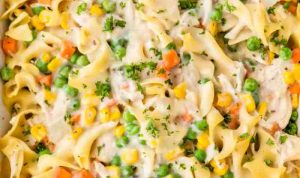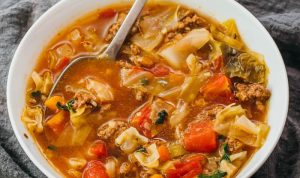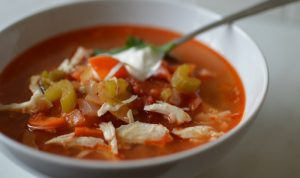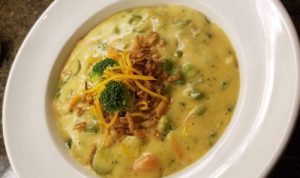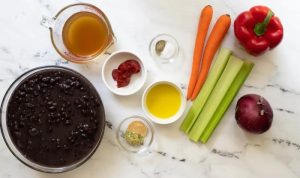A Culinary Journey Through Beef Soup: An Exclusive Interview: Beef Soups Recipes

Source: tasteofhome.com
Beef soups recipes – The world of beef soup is vast and varied, a testament to culinary creativity across cultures and regions. From the rich, slow-cooked stews of Europe to the fragrant broths of Asia, beef soup offers a comforting warmth and a spectrum of flavors. This exclusive interview delves into the heart of beef soup, exploring its diverse types, key ingredients, preparation techniques, and creative serving suggestions.
Types of Beef Soups: A Global Perspective
Beef soup transcends geographical boundaries, taking on unique characteristics based on regional traditions and readily available ingredients. The following table categorizes some popular varieties, highlighting their distinctive features.
| Soup Type | Description | Regional Variations | Unique Aspects |
|---|---|---|---|
| Beef Stew | A hearty, thick soup with chunks of beef and vegetables, often slow-cooked. | Irish stew (lamb may be included), French beef bourguignon (red wine-based), Hungarian goulash (paprika-rich). | Variations in meat cuts, vegetable combinations, and the use of wine or spices. |
| Pho | A Vietnamese noodle soup with a rich, flavorful broth, often featuring beef, rice noodles, and herbs. | Northern Pho (often with beef brisket and bone marrow), Southern Pho (often with meatballs and tendon). | The use of star anise, cinnamon, cloves, and other aromatic spices in the broth. |
| French Onion Soup with Beef | A classic French soup with caramelized onions, beef broth, and often topped with croutons and cheese. | Variations in the type of beef used (e.g., short ribs, chuck roast), and the addition of other vegetables like mushrooms. | The deep caramelization of the onions contributes significantly to the soup’s rich flavor. |
| Consommé | A clear, flavorful broth made from beef stock, often clarified to remove any cloudiness. | Variations include consommé double (double-clarified for extra clarity), and additions of vegetables or herbs for added flavor. | The emphasis on clarity and a clean, refined flavor profile. |
Comparing Beef Stew, Pho, and French Onion Soup, we see a clear distinction in both ingredients and techniques. Beef stew relies on slow cooking to tenderize tough cuts of beef, resulting in a hearty, chunky soup. Pho utilizes a complex broth simmered with aromatic spices, creating a lighter yet deeply flavorful soup. French onion soup highlights the caramelization of onions as a central flavor component, building a rich and savory base for the beef broth.
Beef Soup Ingredients: A Symphony of Flavors
The quality of ingredients directly impacts the final flavor of the soup. Careful selection of beef cuts and vegetables is crucial for achieving a balanced and delicious result.
Suitable Beef Cuts:
- Chuck Roast: A flavorful, tougher cut that becomes incredibly tender with long, slow cooking.
- Short Ribs: Rich in flavor and marbling, perfect for stews and slow-cooked soups.
- Brisket: A flavorful cut that yields tender, juicy shreds when cooked low and slow.
- Oxtail: Adds depth of flavor and richness to the broth.
- Beef Shanks: Similar to oxtail, offering significant flavor and collagen for thickening.
Role of Vegetables:
- Carrots: Add sweetness and color.
- Celery: Provides a subtle earthy flavor and aroma.
- Onions: Contribute a savory base and complexity.
- Potatoes: Add thickness and a creamy texture.
Unconventional Vegetables in Beef Soup: A recipe incorporating parsnips, rutabagas, and turnips could add a unique sweetness and earthiness to a beef soup. The parsnips offer a subtle sweetness, the rutabagas a slightly peppery note, and the turnips a mild, slightly sweet flavor. These vegetables, when slow-cooked with the beef, would meld beautifully, adding depth and complexity to the broth.
Beef Soup Preparation Techniques: Mastering the Broth
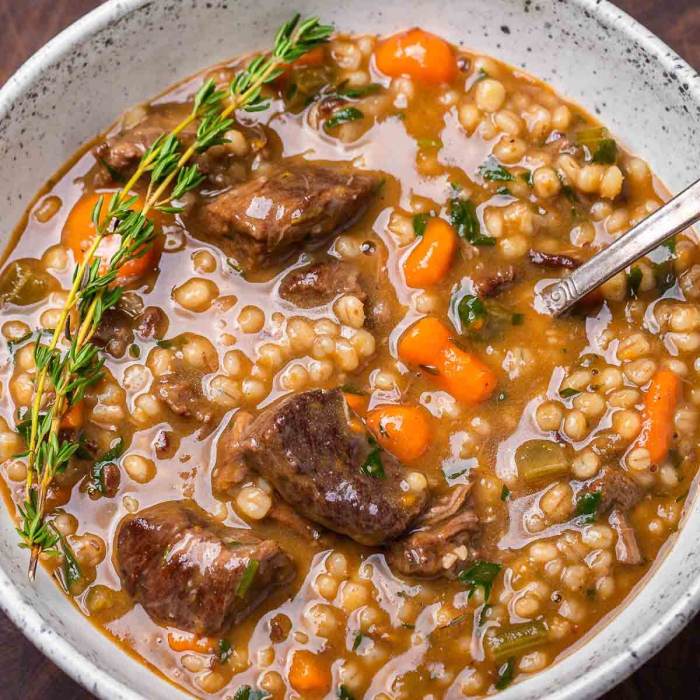
Source: sipandfeast.com
The preparation of beef soup involves a series of steps, each contributing to the final flavor and texture. Mastering these techniques is essential for creating a truly exceptional soup.
Preparing a Classic Beef Broth:
- Brown the beef cubes in a large pot or Dutch oven over medium-high heat to develop deep flavor.
- Add chopped vegetables (onions, carrots, celery) and sauté until softened.
- Pour in cold water, ensuring the beef is fully submerged. Add any desired herbs and spices.
- Bring to a boil, then reduce heat to low, cover, and simmer for at least 3 hours, or up to 6-8 hours for a richer flavor.
- Strain the broth through a fine-mesh sieve or cheesecloth to remove solids.
Thickening Beef Soup:
| Method | Description | Pros | Cons |
|---|---|---|---|
| Roux | A mixture of butter and flour cooked together to create a thickening agent. | Creates a smooth, creamy texture. | Requires careful cooking to avoid lumps. |
| Cornstarch Slurry | A mixture of cornstarch and cold water whisked into the soup. | Easy to use and creates a clear thickening. | Can result in a slightly gummy texture if not properly incorporated. |
| Vegetables | Pureeing some of the cooked vegetables and returning them to the soup. | Adds flavor and nutrients while thickening. | May result in a less smooth texture compared to roux or cornstarch. |
Proper Seasoning: Salt and pepper are fundamental, balancing the overall flavor. Herbs such as bay leaves, thyme, and rosemary add depth and complexity. Spices like black peppercorns, cloves, or allspice can contribute warm, earthy notes. Adjust seasoning throughout the cooking process to achieve the desired flavor profile.
Serving and Variations of Beef Soup: Expanding the Possibilities, Beef soups recipes
Beef soup can be served in countless ways, from simple elegance to creative culinary presentations. Dietary adaptations allow for inclusivity and cater to diverse needs.
Serving Suggestions:
- Garnish with fresh herbs (parsley, cilantro, chives).
- Serve with crusty bread for dipping.
- Add a dollop of sour cream or crème fraîche.
- Top with shredded cheese (e.g., Parmesan, Gruyère).
- Accompany with a side salad or steamed vegetables.
Dietary Adaptations:
- Low-sodium: Reduce or omit added salt, use low-sodium broth.
- Low-carb: Reduce or omit starchy vegetables (potatoes, carrots).
- Vegetarian: Substitute beef with hearty vegetables like mushrooms, lentils, or beans.
Beef Soup Recipes by Cooking Time:
| Recipe | Cooking Time | Description | Notes |
|---|---|---|---|
| Quick Beef Noodle Soup | 30 minutes | Uses pre-cooked beef and readily available ingredients. | Ideal for weeknight meals. |
| Simple Beef and Vegetable Soup | 1 hour | Features readily available vegetables and a short simmer time. | A good option for a light yet flavorful soup. |
| Hearty Beef Stew | 3-4 hours | Slow-cooked beef stew with tender beef and vegetables. | Perfect for a comforting, hearty meal. |
| Slow Cooker Beef Bourguignon | 6-8 hours | Rich red wine-based beef stew, slow-cooked for maximum flavor. | Ideal for make-ahead meals. |
Visual Representation of Beef Soup Recipes: A Feast for the Eyes
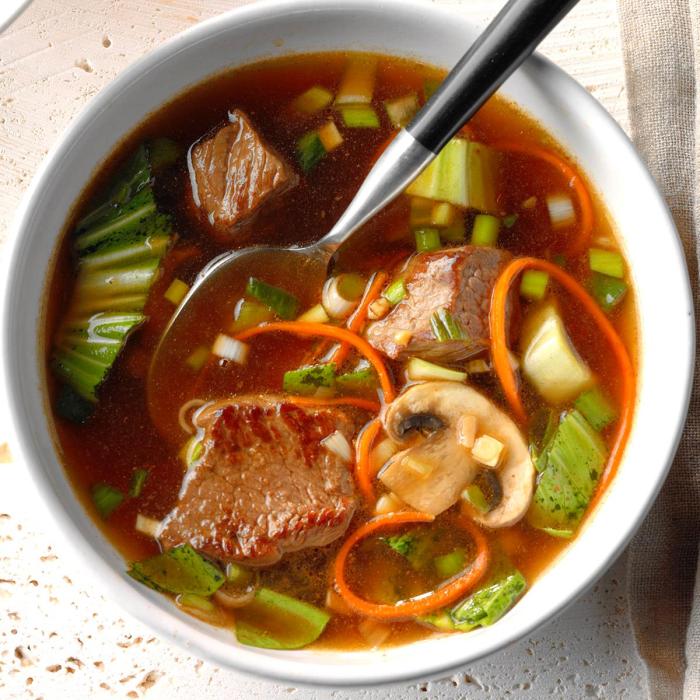
Source: windows.net
The visual appeal of beef soup is as important as its taste. The interplay of colors, textures, and ingredient arrangement contributes significantly to the overall dining experience.
Hearty Beef Stew: A hearty beef stew presents a rich tapestry of colors and textures. The deep brown of the beef contrasts beautifully with the vibrant orange of carrots, the deep green of peas, and the creamy white of potatoes. The stew’s chunky texture is visually appealing, suggesting a satisfying and hearty meal. The overall presentation can be enhanced by garnishing with fresh herbs and a sprinkle of paprika.
Beef soups, a culinary staple worldwide, offer diverse flavor profiles depending on the ingredients. A popular and nutritious variation is vegetable beef soup, and for those seeking a well-regarded recipe, consider checking out this excellent resource for a vegetable beef soup recipe best suited for home cooks. Mastering this recipe can enhance your overall beef soup repertoire, providing a foundation for further experimentation and refinement of your culinary skills.
Clear Beef Broth vs. Thicker Soup: A clear beef broth exhibits a clean, translucent quality, showcasing the subtle hues of the broth itself. In contrast, a thicker, chunkier beef soup presents a more robust visual appeal, with visible pieces of beef and vegetables adding texture and depth to the overall appearance. The color of a thicker soup is typically richer and more intense.
Beef Noodle Soup: The visual appeal of beef noodle soup is enhanced by the interplay of colors and textures. The clear or lightly colored broth provides a backdrop for the vibrant colors of the noodles, beef slices, and herbs. The contrast between the smooth noodles and the tender beef creates visual interest, and the scattered herbs add pops of green or other colors depending on the herbs used.
Careful arrangement of ingredients in the bowl can further enhance the visual appeal.
FAQ Summary
What are the best beef cuts for soup?
Chuck roast, brisket, and short ribs are excellent choices for beef soup due to their high collagen content, resulting in a rich and flavorful broth. Shank is also a good option.
How long should beef soup simmer for optimal flavor?
Simmering time varies depending on the cut of beef and desired tenderness. Generally, a minimum of 2-3 hours is recommended for a robust flavor, with longer simmering times (up to 6-8 hours) yielding a more tender and flavorful result.
Can I freeze leftover beef soup?
Yes, beef soup freezes well. Allow it to cool completely before storing in airtight containers for up to 3 months.
How can I make my beef soup thicker?
Several methods exist, including using a roux, cornstarch slurry, or pureeing some of the cooked vegetables.

